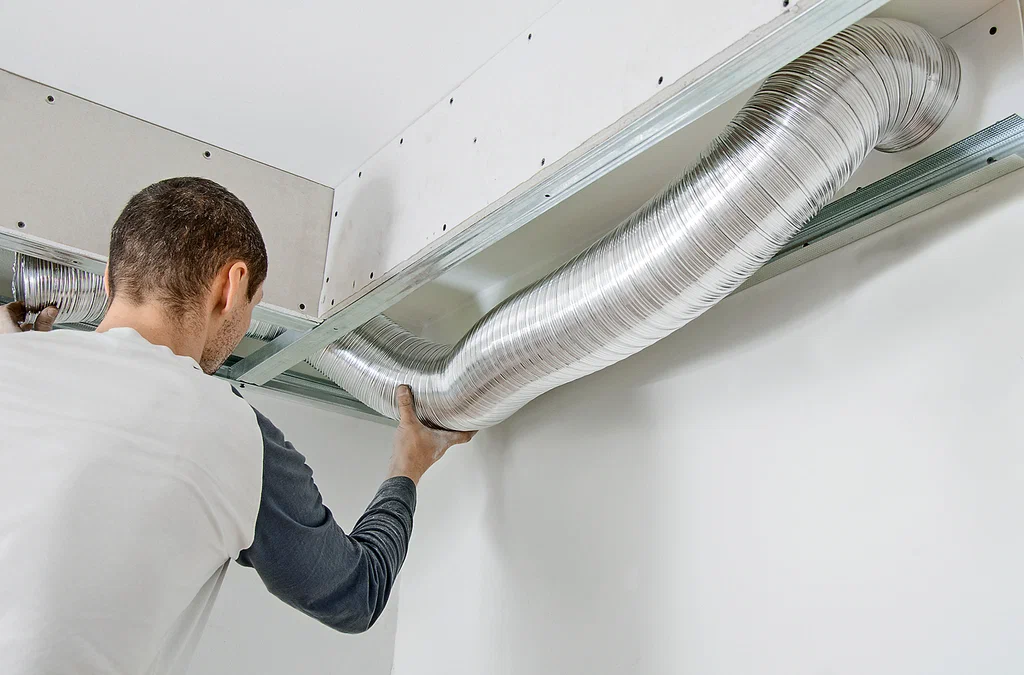
Duct installation is a critical part of any home’s heating, ventilation, and air conditioning (HVAC) system. It involves the installation of ducts that are used to deliver and remove air throughout the home, ensuring that indoor environments remain comfortable and healthy. Whether you’re building a new home, upgrading your existing system, or replacing old ducts, proper duct installation is key to ensuring the efficiency of your HVAC system. In this article, we’ll dive into what duct installation is, why it’s important, and how it can benefit your home.
1. What Is Duct Installation?
Duct installation refers to the process of setting up a network of ducts that transport air throughout a home. These ducts are typically made of sheet metal, fiberglass, or flexible materials and are used to deliver heated or cooled air from the HVAC system to various rooms in the house. Additionally, ducts are responsible for removing stale air, allowing for better ventilation.
The Components of Ductwork
- Supply Ducts: These ducts carry heated or cooled air from the HVAC unit to different areas of the home.
- Return Ducts: These ducts remove stale air and send it back to the HVAC system for reheating or cooling.
- Registers and Vents: These are the openings where the conditioned air enters or exits a room.
2. Why Is Proper Duct Installation Important?
1. Improved Energy Efficiency
Properly installed ducts ensure that air travels through the system with minimal loss, resulting in more energy-efficient heating and cooling. If ducts are poorly installed or have leaks, air can escape, making it harder for the HVAC system to maintain the desired temperature, which can lead to increased energy consumption and higher utility bills.
2. Enhanced Comfort
Well-installed ducts ensure that air is evenly distributed throughout the home. This helps maintain a consistent temperature in every room, preventing hot or cold spots. Efficient ductwork can also improve air circulation, making your home feel more comfortable overall.
3. Better Air Quality
When ducts are installed correctly, they are less likely to harbor dust, dirt, or debris, which can be harmful to your indoor air quality. Leaky or poorly insulated ducts, on the other hand, can allow allergens, dust, and mold to enter the airflow, leading to poor air quality and potentially causing health issues.
4. Increased System Longevity
Proper duct installation reduces the strain on your HVAC system. Ducts that are too small, too large, or incorrectly installed can lead to poor airflow, which puts unnecessary stress on the system. By ensuring that the ducts are sized and positioned properly, you help the HVAC system run smoothly for a longer period, reducing the need for costly repairs or early replacement.
5. Reduced Noise
Leaky or improperly sized ducts can lead to noisy airflow, especially if the ducts are too narrow for the volume of air being pushed through them. Proper installation helps to minimize this issue, creating a quieter environment in your home.
3. Signs That You Need Duct Installation or Replacement
While ducts can last for many years, there are some signs that may indicate it’s time to install new ducts or replace old ones:
- Poor airflow: If certain rooms feel stuffy or the airflow is weak, it may be a sign of blocked, disconnected, or improperly sized ducts.
- Increased energy bills: A sudden increase in your energy bills, despite consistent usage, may indicate that your ducts are leaking or inefficient.
- Visible damage: If your ducts are old and damaged, you may notice visible wear, cracks, or holes in them.
- Uneven temperatures: If some areas of your home are consistently hotter or colder than others, it could be a sign of issues with your ductwork.
4. How Is Duct Installation Done?
Step 1: Planning and Design
The first step in duct installation is designing the duct system. A professional HVAC technician will evaluate your home’s layout, size, and heating/cooling needs. They will then design a system that ensures efficient airflow and temperature distribution.
Step 2: Choosing Materials
Ducts can be made from various materials, including galvanized steel, aluminum, flexible ducting, and fiberglass. The material choice depends on factors such as cost, durability, and ease of installation.
Step 3: Installation of Ductwork
Once the design and materials are selected, the installation process begins. The technician will measure and cut the ducts to fit the spaces between walls, ceilings, and floors. The ducts are then connected to the HVAC system and secured in place.
Step 4: Sealing and Insulating
After the ducts are installed, they will be sealed to prevent air leaks. Insulating the ducts is also essential for preventing energy loss, especially if they are installed in unconditioned spaces like attics or basements.
Step 5: Testing the System
Once everything is in place, the technician will test the system to ensure that air is flowing properly through all ducts and that the HVAC system is working efficiently.
5. What Are the Different Types of Ducts?
There are several types of ducts commonly used in residential homes, each with its own set of benefits and applications:
1. Flexible Ducts
Flexible ducts are made of a flexible plastic or metal material and are easy to install in tight spaces. They are typically used in homes with less space for rigid ducting.
Benefits:
- Easy to install.
- Cost-effective.
- Ideal for retrofitting older homes.
2. Rigid Sheet Metal Ducts
Rigid sheet metal ducts are the most common type and are usually made from galvanized steel or aluminum. They are durable, provide excellent airflow, and are resistant to mold growth.
Benefits:
- Durable and long-lasting.
- High airflow efficiency.
- Ideal for new construction or larger homes.
3. Fiberglass Ducts
Fiberglass ducts are made from flexible fiberglass insulation material. They provide excellent thermal insulation and are resistant to moisture, making them ideal for areas prone to humidity.
Benefits:
- Good insulation properties.
- Prevents heat loss or gain.
- Ideal for moist environments.
4. Spiral Ducts
Spiral ducts are a type of metal ducting that is rolled into a spiral shape. They are commonly used for commercial buildings but can also be used in residential installations.
Benefits:
- Aesthetic appeal due to their unique look.
- High airflow capacity.
- Easy to install in open spaces.
Conclusion
Duct installation is a vital component of your home’s HVAC system, directly influencing energy efficiency, comfort, air quality, and the longevity of your heating and cooling system. Properly installed ducts ensure that your home stays comfortable year-round while keeping your utility bills in check. Whether you’re building a new home or replacing old, inefficient ductwork, investing in high-quality duct installation is essential for maintaining a comfortable and healthy living environment. Always rely on professional HVAC technicians to ensure your ducts are correctly sized, sealed, and installed for optimal performance.
FAQs
1. Why is duct installation important?
Duct installation ensures proper airflow, energy efficiency, and indoor comfort. Well-installed ducts help reduce energy bills, improve air quality, and prolong the life of your HVAC system.
2. How do I know if my ducts need replacing?
Signs of faulty ducts include poor airflow, increased energy bills, uneven temperatures, or visible damage like cracks and holes in the ductwork.
3. What materials are used for ducts?
Common duct materials include flexible plastic or metal (such as aluminum and galvanized steel), fiberglass, and spiral ducts, each offering different benefits for efficiency and durability.
4. Can I install ducts myself?
Duct installation is a complex process best handled by professional HVAC technicians to ensure proper sizing, sealing, and airflow for optimal performance.
5. How long do ducts last?
Ducts typically last around 15-20 years, but their lifespan can vary based on material, maintenance, and exposure to wear and tear.




